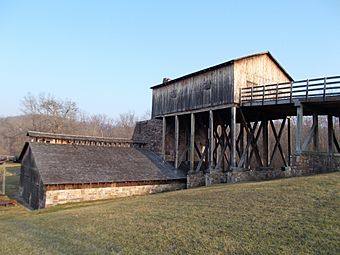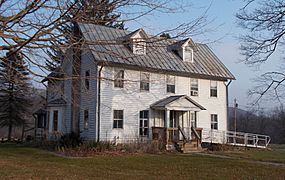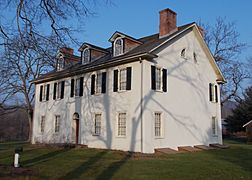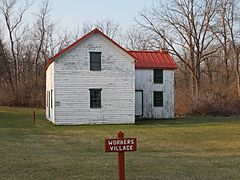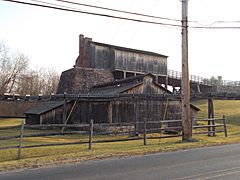Curtin Village facts for kids
Curtin Village, also called Eagle Ironworks, is a special place in Boggs Township, Centre County, Pennsylvania. It's like a preserved old town that shows how people lived and worked long ago. This historic area has eighteen important buildings and three other structures that tell a story about the past.
Contents
A Look Back in Time
How Curtin Village Began
Curtin Village started way back in 1810. It was founded by Roland Curtin, Sr., and Miles Boggs. Roland Curtin, Sr., was the father of Andrew Gregg Curtin. Andrew Gregg Curtin later became the governor of Pennsylvania during the American Civil War.
What Was the Eagle Ironworks?
The main part of Curtin Village was the Eagle Ironworks. This was a factory where people made iron. Iron was very important for building things in the 1800s. The ironworks helped the village grow and thrive.
Important Buildings and Structures
Many buildings in Curtin Village are still standing. You can see the iron master's mansion, built in 1830. This was the home of the person in charge of the ironworks. There's also a beautiful Victorian-style house from the late 1800s.
The Eagle Furnace stack, built in 1847, is another key part. This tall structure was where iron ore was heated to make iron. You can also find the remains of a grist mill. A grist mill was used to grind grain into flour. Many houses where the workers lived are also still there. There's even an old canal basin, which was once a busy waterway.
The End of an Era
The Eagle Ironworks operated for over a century. It finally closed its doors in 1921. After it closed, the village became a quiet place.
Protecting History
Saving Curtin Village
Today, people work hard to keep Curtin Village safe. These people are called historic preservationists. They want to make sure these old buildings and stories are not lost. The Pennsylvania Historical and Museum Commission owns the site.
Visiting Curtin Village
The Roland Curtin Foundation helps run the site. It is known as the Curtin Village at Eagle Ironworks Historical Site. Visitors can learn about life in an old iron-making village. It's a great way to see how people lived and worked long ago.
A National Treasure
Because of its importance, Curtin Village was added to the National Register of Historic Places in 1971. This means it is recognized as a special historic place in the United States.
Gallery


